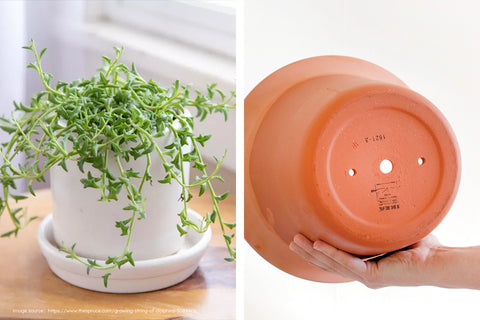Native to semi-desert regions of Mexico, Central America and South America, Echeveria is popular rosette succulents with a wide ranging of colors. Due to its symmetrical leaves and rich varieties, they are very popular in succulent centerpieces, succulent fairy gardens, party favors and terrarium projects.
Echeveria is super easy to care for. However, especially for succulent beginners, it is hard to maintain their beautiful compact shape and vibrant color without proper care. If you are struggling for same issue. Keep reading and get right care instruction of Echeveria.
Indoor or Outdoor?
Echeveria can thrive both indoors and outdoors. But since they demand bright light, you must be vigilant if you plan to use them as indoor plants. Echeveria prefers at least 6 hour sunlight per day. As indoor succulents, grow them in location with indirect bright sunlight such as near the window, porch or under grow light. Otherwise, they would stretch out/grow leggy to prone more light. Outdoor growing can take full to partial sun. Shade cloth will protect them from sunburn on hot afternoons in summer. You may wonder: 15 Succulents That Uneasy to Go Leggy.
Ideal Temperature
As soft succulents, Echeveria is not cold hardy down to 40°F (zone 9). Before freezing temperatures, move them indoors to help them survive. Did winter catch you off guard, leaving your Echeveria succulents out in the cold? Don't panic! This guide is your lifeline to salvaging those succulents as best as possible.
Echeveria is not tolerant of extreme heat, especially temperatures above 95°F (35°C). When the mercury rises, move your Echeveria to a cooler, shaded location. High temperatures coupled with excessive watering can lead to root rot in Echeveria. You may wonder: How to save Rotted Succulents.
Echeveria thrives in temperatures between 40-90°F (5-32°C). In temperatures ranging from 40-60°F (5-15°C), Echeveria displays stunning stress-induced coloration, with leaves taking on rich hues of purple, pink, and red.
Water Requirements
Watering is perhaps the most critical part of Echeveria care instruction. Unlike most plants, succulents can easily get overwatered especially for some varieties which are very sensitive to water like Echeveria Ice Green.
So to avoid Echeveria growth issues, you should water succulents when the cactus soil mix dries out. The right way to water succulents is using a squeeze bottle or a long neck water can to water the top soil (not water the leaves) till the water leak out from the drainage hole. Click here to check if you are overwatering or underwatering your succulents.
For succulents with farina leaves, like some Echeveria Laui, Echeveria Cubic Frost, Echeveria Afterglow, you can also try bottom watering. Simply place the potted succulent in a tray filled with water for about 15-20 minutes. Once you see the soil surface become moist, indicating the bottom watering is complete, take the potted plant out and let the excess water drain away.

If you want to learn full guide about watering succulents, please click the video below!
Soil & Drainage
Like all cactus and succulents, Echeveria loves light-weight, well drainage soil to live in. You can simply mix perlite, gritty rocks, and soil can make a good cactus soil mix for them. If you prefer organic gardening, we offer organic and professional cactus soil mix to you.
At the same time, make sure your pots have drainage holes at the bottom. These holes allow excess water to drain out after watering your Echeveria plant.
Image Credit: thesrpuce.com
Propagation
Echeveria can be propagated from cuttings of offsets, leaves, and beheadings. Check out information and get more details about Echeveria Propagation. Click here to learn propagate succulents from leaves.

What to Do When Your Echeveria Blooms
Echeveria plants are prized not only for their striking rosettes but also for their beautiful blooms. From spring to summer, these succulents produce colorful, bell-shaped flowers that emerge between their leaves.
When your Echeveria blooms, take the time to appreciate their exquisite flowers. Observe the unfolding process and capture some precious photos if you wish.
It's important to note that blooming requires energy from the Echeveria plant. Blooming Echeveria plants may attract aphids and mealybugs, which can be detrimental to their health. You should remove the flower stalks, use the clean shears to make clean cuts just above the base of the stalk.
Diseases and Pests
Dealing with diseases and pests in caring for Echeveria succulents isn't always smooth sailing. The most common issues include leaf melting, root rot, leaf spots, and scale insects.
Leaf melting: If Echeveria leaves become translucent, it's usually due to overwatering, leading to waterlogged leaves. To prevent melting from turning into rot, promptly remove affected leaves.
Root rot: Rotting roots turn the plant black, often caused by prolonged exposure to moist soil. If you notice excessive leaf drop, it's an early sign of root rot. Use a knife or scissors to trim away the affected parts promptly, which might salvage the healthier sections.
Leaf spots: Echeveria succulents may develop brown, black, or white spots due to sunburn or fungal infections. If you're puzzled by these spots, check out our blog on identifying succulent spots for clarity.
Scale insects: Echeverias are quite attractive to scale insects, especially during flowering or when producing new tender leaves. Scale insects can deform leaves and even cause them to melt. Once detected, thoroughly inspect the plant and use either 75% alcohol or systemic insecticides to rid them.
Top 10 Echeverias for Beginners
1. Echeveria 'Rainbow'
2. Echeveria 'Chihuahuaensis'
3. Echeveria 'Mebina'
4. Echeveria 'Suyon'
5. Echeveria 'Melaco'
6. Echeveria Purpusorum
7. Echeveria 'Crispate Beauty'
8. Echeveria Cubic Frost
9. Echeveria Laui
10. Echeveria Subcorymbosa Lau 026
Conclusion
Whether you're delving into indoor or outdoor gardening, Echeveria succulents are an excellent choice to begin your journey. With their captivating beauty and relatively simple care requirements, these plants are perfect for novice gardeners. if you encounter any challenges along the way, don't hesitate to reach out to TNG NEXT GARDENER for expert support!




























1 thought on “Care Instructions For Echeveria Succulent Plant”